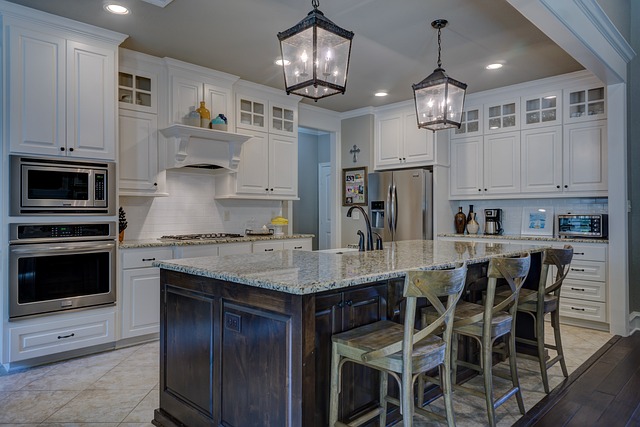Kaleidoscopic Kitchens: The Rise of Color-Shifting Tiles in Modern Home Design
A vibrant kitchen bustles with activity as sunlight streams through the window, casting a dance of colors across the walls. The homeowner smiles, marveling at how the iridescent tiles shimmer and change hues, transforming the heart of their home into a dynamic, ever-evolving space. Welcome to the world of color-shifting tiles, the latest trend captivating interior designers and homeowners alike.

The Science of Shimmer: Understanding Color-Shifting Tiles
At the heart of color-shifting tiles lies a fascinating interplay of light and nanoscale structures. These tiles are typically crafted from materials like glass or ceramic, coated with ultra-thin layers of metal oxides. As light hits the surface, it interacts with these layers, creating interference patterns that result in the perception of different colors from various angles.
This phenomenon, known as thin-film interference, is the same principle that creates the shimmering colors on soap bubbles or oil slicks. In the case of color-shifting tiles, manufacturers can precisely control the thickness and composition of these layers to produce specific color ranges and effects. Some tiles may shift between subtle, complementary hues, while others offer dramatic transformations across the entire spectrum.
From Concept to Kitchen: The Evolution of Iridescent Surfaces
The use of iridescent materials in design is not entirely new. Ancient civilizations, including the Romans and Persians, incorporated iridescent glass into their decorative arts. However, the application of this technology to large-scale architectural elements, particularly in kitchens, is a recent innovation.
The development of color-shifting tiles for home use began in the early 2000s, primarily in the automotive and fashion industries. As manufacturing techniques improved and costs decreased, interior designers began experimenting with these materials in residential spaces. The kitchen, with its need for durable, easy-to-clean surfaces and its role as a central gathering place, emerged as the perfect canvas for this bold design statement.
Designing with Dimension: Incorporating Color-Shifting Tiles
Integrating color-shifting tiles into kitchen design requires a thoughtful approach. These dynamic surfaces can serve as striking focal points or subtle accents, depending on their application. Here are some popular ways designers are incorporating this trend:
-
Backsplashes: A color-shifting backsplash can transform a kitchen from ordinary to extraordinary. As natural and artificial light changes throughout the day, the backsplash becomes a living work of art.
-
Island Facades: Wrapping a kitchen island in iridescent tiles creates a captivating centerpiece that seems to change as people move around the space.
-
Accent Walls: For a bold statement, an entire wall of color-shifting tiles can turn a kitchen into a dynamic, immersive environment.
-
Cabinet Inserts: For a more subtle approach, designers are using small sections of iridescent tiles as inserts in glass-front cabinets, adding depth and intrigue to storage spaces.
The Psychology of Color (Shifting): Impact on Mood and Perception
The introduction of color-shifting tiles in kitchens goes beyond mere aesthetics; it can significantly impact the mood and perception of the space. Research in color psychology suggests that our surroundings can influence our emotions and behaviors. In the context of color-shifting tiles, this effect is amplified by the dynamic nature of the surfaces.
The constantly changing hues can create a sense of energy and movement, making the kitchen feel more alive and engaging. This can be particularly beneficial in smaller kitchens, where the shifting colors can create an illusion of expanded space. Additionally, the interplay of light and color can evoke feelings of joy, creativity, and wonder, transforming the kitchen into a more inspiring and enjoyable environment.
Practical Considerations: Maintenance and Longevity
While the visual appeal of color-shifting tiles is undeniable, practical considerations are equally important. Fortunately, many manufacturers have developed these tiles with durability and ease of maintenance in mind. Most color-shifting tiles are resistant to stains, scratches, and fading, making them well-suited for the demands of a busy kitchen.
Cleaning these tiles typically requires nothing more than a soft cloth and mild detergent. However, it’s essential to avoid abrasive cleaners that could damage the delicate surface layers responsible for the color-shifting effect. When properly cared for, these tiles can maintain their dynamic appearance for many years, offering lasting value and enjoyment.
The Future is Bright (and Colorful): Emerging Trends and Technologies
As color-shifting tiles gain popularity, manufacturers and designers are pushing the boundaries of what’s possible. Some exciting developments on the horizon include:
-
Interactive Tiles: Researchers are exploring tiles that can change color in response to touch or temperature, allowing for even more dynamic and personalized environments.
-
Smart Integration: The integration of color-shifting tiles with smart home systems could allow homeowners to control the appearance of their kitchen with voice commands or smartphone apps.
-
Sustainable Production: As sustainability becomes increasingly important in home design, manufacturers are developing color-shifting tiles using eco-friendly materials and processes.
-
Textured Surfaces: Combining color-shifting properties with textured surfaces is creating new possibilities for tactile and visual experiences in kitchen design.
The introduction of color-shifting tiles in kitchen design marks a significant shift in how we think about home interiors. By blending cutting-edge technology with artistic expression, these dynamic surfaces offer a unique way to personalize and enliven our living spaces. As the trend continues to evolve, it promises to bring even more wonder and creativity into the heart of our homes, transforming kitchens from mere functional spaces into captivating, ever-changing works of art.





